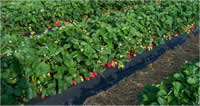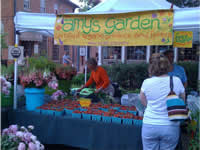Plasticulture Production
go.ncsu.edu/readext?183343
en Español / em Português
El inglés es el idioma de control de esta página. En la medida en que haya algún conflicto entre la traducción al inglés y la traducción, el inglés prevalece.
Al hacer clic en el enlace de traducción se activa un servicio de traducción gratuito para convertir la página al español. Al igual que con cualquier traducción por Internet, la conversión no es sensible al contexto y puede que no traduzca el texto en su significado original. NC State Extension no garantiza la exactitud del texto traducido. Por favor, tenga en cuenta que algunas aplicaciones y/o servicios pueden no funcionar como se espera cuando se traducen.
Português
Inglês é o idioma de controle desta página. Na medida que haja algum conflito entre o texto original em Inglês e a tradução, o Inglês prevalece.
Ao clicar no link de tradução, um serviço gratuito de tradução será ativado para converter a página para o Português. Como em qualquer tradução pela internet, a conversão não é sensivel ao contexto e pode não ocorrer a tradução para o significado orginal. O serviço de Extensão da Carolina do Norte (NC State Extension) não garante a exatidão do texto traduzido. Por favor, observe que algumas funções ou serviços podem não funcionar como esperado após a tradução.
English
English is the controlling language of this page. To the extent there is any conflict between the English text and the translation, English controls.
Clicking on the translation link activates a free translation service to convert the page to Spanish. As with any Internet translation, the conversion is not context-sensitive and may not translate the text to its original meaning. NC State Extension does not guarantee the accuracy of the translated text. Please note that some applications and/or services may not function as expected when translated.
Collapse ▲Plasticulture Information for N.C. Strawberry Growers
 The plasticulture strawberry season in N.C. begins in late April to early May and lasts six to eight weeks.
The plasticulture strawberry season in N.C. begins in late April to early May and lasts six to eight weeks.
The development of North Carolina’s strawberry plasticulture industry over the last 25 years has been one of the real success stories of a special partnership between land-grant university scientists at N.C. State University and a statewide system of publically supported research stations. Seven of the state’s 18 research stations (located in Castle Hayne, Clayton, Clinton, Fletcher, Jackson Springs, Salisbury and Laurel Springs), have their “footprint” directly on the $25 million strawberry plasticulture industry in North Carolina. The plasticulture production system, also called the “annual hill plastic mulch system,” originated in California and Florida in the 1960s, but was not seriously evaluated in North Carolina until the early 1980s. N.C. State scientists found that the plasticulture method offered several distinct advantages over the traditional matted-row system, including larger fruit size, higher marketable yields and a longer picking season.
 The berries are so much larger in size with this system that pickers can harvest three to four times faster on raised, plastic mulch-covered beds than on lower, matted-row beds. This breakthrough in harvest efficiency has made it possible for North Carolina farmers to compete in a variety of important “pre-pick” markets, including specialty grocers that feature locally grown produce, farmers markets, roadside stands, high-end restaurants and CSAs (Community Supported Agriculture). Of course, customer harvest, also known as U-pick or pick-your-own, is still a popular marketing method for strawberry farms located near cities and towns. But, the proportion of the total crop that can be successfully marketed U-pick relative to pre-pick has changed dramatically in recent years. Today, people are demanding more pre-picked fruit, and the proportion of the crop that is sold U-pick has declined from around 80 percent in the late 1990s, to as little as 20 percent in the late 2000s.
The berries are so much larger in size with this system that pickers can harvest three to four times faster on raised, plastic mulch-covered beds than on lower, matted-row beds. This breakthrough in harvest efficiency has made it possible for North Carolina farmers to compete in a variety of important “pre-pick” markets, including specialty grocers that feature locally grown produce, farmers markets, roadside stands, high-end restaurants and CSAs (Community Supported Agriculture). Of course, customer harvest, also known as U-pick or pick-your-own, is still a popular marketing method for strawberry farms located near cities and towns. But, the proportion of the total crop that can be successfully marketed U-pick relative to pre-pick has changed dramatically in recent years. Today, people are demanding more pre-picked fruit, and the proportion of the crop that is sold U-pick has declined from around 80 percent in the late 1990s, to as little as 20 percent in the late 2000s.
Several strawberry plasticulture production recommendations have changed over the last decade, and this section of the Strawberry Growers Information Portal provides current information on a full range of plasticulture production-related topics, from variety selection to plant tissue testing and the latest recommendations on row cover management. A number of the changes and improvements in strawberry plasticulture recommendations that have occurred over the last 10 years are largely the outcome of a continuing collaboration between N.C . State University researchers and breeders, the state’s research stations and the Agronomic Division of the N.C. Department of Agriculture & Consumer Services.
Current research efforts include the development of more sustainable production techniques, finding an alternative to methyl bromide fumigation, breeding a true North Carolina plasticulture strawberry and introducing high tunnel growing systems for both conventional and organic strawberry production to extend the season.
Preliminary Considerations
Before setting the first strawberry plant, there are several preliminary considerations to address, including regional adaptation and yields, site, soil, equipment, plant material, nursery plant health and varieties.
Production Schedule
Growing strawberries using the plasticulture system is a year-round activity that begins with ordering your plant materials and soil testing in early summer and concludes with the removal of the plastic mulch and plowing under the strawberry plants the following summer


